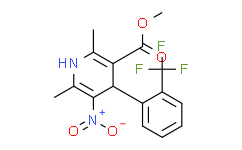| Cas No.: | 71145-03-4 |
| Chemical Name: | BAY-K-8644 |
| Synonyms: | ( /-) BAYK8644;(±)-Bay K 8644;(±)BayK8644;(+/-)-BAY-K 8644;(1,4-dihydro-2,6-dimethyl-5-nitro-4-[2-(trifluoromethyl)-phenyl]-3-pyridine carboxylic acid methyl ester;1,4-D;2-aziridinecarbonitrile;2-cyano-2-aziridine;AC1L3M8Z;AC1Q4RJZ;CHEMBL177264;CTK1C2552;methyl-1,4-dihydro-2,6-dimethyl-5-nitro-4-(2-trifluoromethylphenyl)-pyridine-3-carboxylate;nitrile of aziridine-2-carboxylic acid;rac-Aziridin-2-carbonitril;BAYK8644;Bay K 8644 |
| SMILES: | CC1=C(C(C2=CC=CC=C2C(F)(F)F)C(=C(C)N1)[N+](=O)[O-])C(=O)OC |
| Formula: | C16H15F3N2O4 |
| M.Wt: | 356.3 |
| Purity: | >98% |
| Sotrage: | 2 years -20°C Powder, 2 weeks 4°C in DMSO, 6 months -80°C in DMSO |
| Description: | Bay K 8644, a dihydropyridine compound, is a specific L-type Ca2+ channel agonist. Bay K 8644 increases Ca2+ influx through sarcolemmal Ca2+ channels by increasing the open time of the channel[1]. |
| In Vivo: | A one time dose as low as 10 μg/kg of Bay K 8644 significantly elevates mean arterial pressure (MAP) in endotoxin-treated hypotensive rats while having minimal effects in normal rats. Bay K 8644 also causes a dose-dependent decrease in heart rate of 37% in endotoxin-treated rats and 39% in control rats[1]. |
| In Vitro: | In newborn rat ventricular cardiomyocytes, Bay K 8644 (1 μM) treatment increases L-type calcium current density in 2-day-old cells. The higher increase of L-type calcium current density by Bay K 8644 in 2-day- than in 7-day-old cultured cells could be interpreted as the result of a difference in the phosphorylation level of calcium channels for each stage of development[2]. |
| References: | [1]. H Satoh, et al. Bay K 8644 increases resting Ca2+ spark frequency in ferret ventricular myocytes independent of Ca influx: contrast with caffeine and ryanodine effects. Circ Res. 1998 Dec 14-28;83(12):1192-204. [2]. J P Gomez, et al. Effects of Bay K 8644 on L-type calcium current from newborn rat cardiomyocytes in primary culture. J Mol Cell Cardiol. 1996 Oct;28(10):2217-29. [3]. N Ives,et al. BAY k 8644, a calcium channel agonist, reverses hypotension in endotoxin-shocked rats. Eur J Pharmacol. 1986 Nov 4;130(3):169-75. |

 To enhance service speed and avoid tariff delays, we've opened a US warehouse. All US orders ship directly from our US facility.
To enhance service speed and avoid tariff delays, we've opened a US warehouse. All US orders ship directly from our US facility.




















